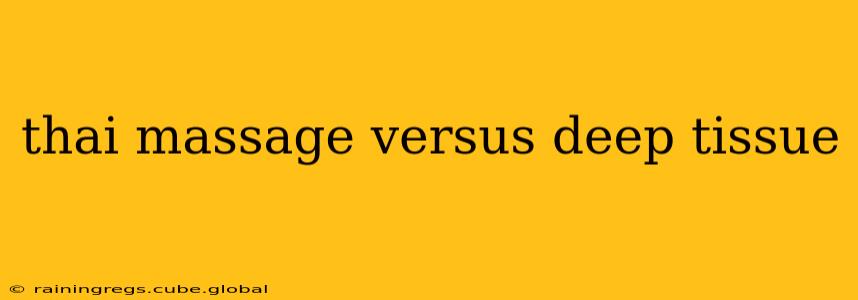Choosing between a Thai massage and a deep tissue massage can be tricky. Both offer therapeutic benefits, but they differ significantly in technique and the resulting experience. This comprehensive guide will explore the key distinctions between these two popular massage therapies, helping you determine which is the better fit for your needs.
What is Thai Massage?
Thai massage, also known as Thai yoga massage, is an ancient healing art originating in Thailand. It's a unique form of bodywork that combines acupressure, assisted stretching, and gentle rocking to promote relaxation and improve flexibility. Unlike many other massage styles, Thai massage is typically performed on a mat on the floor, with the recipient clothed. The therapist uses their hands, elbows, knees, and feet to apply pressure to specific energy lines (Sen lines) throughout the body.
Key Characteristics of Thai Massage:
- Focus on Energy Lines: The massage targets Sen lines, believed to be channels of energy throughout the body. Unblocking these lines is thought to promote improved circulation and overall well-being.
- Passive Stretching: The therapist uses your body weight and leverage to gently stretch and lengthen muscles, improving flexibility and range of motion.
- Acupressure Points: Pressure is applied to specific points along the Sen lines, similar to acupressure, to stimulate energy flow and relieve tension.
- Full Body Treatment: Thai massage typically involves working on the entire body, from head to toe.
What is Deep Tissue Massage?
Deep tissue massage focuses on the deeper layers of muscle and fascia (the connective tissue surrounding muscles). This type of massage uses slower, more deliberate strokes and deeper pressure to release chronic muscle tension and address pain in specific areas. It's often used to treat conditions like muscle strains, back pain, and repetitive stress injuries. Unlike Thai massage, deep tissue massage is typically performed on a massage table with the recipient undressed or wearing comfortable clothing.
Key Characteristics of Deep Tissue Massage:
- Targeted Approach: Deep tissue massage often focuses on specific areas of pain or tension, working to release knots and adhesions.
- Deeper Pressure: Therapists use firm, sustained pressure to reach deeper muscle layers. This can be quite intense, and communication with your therapist about pressure levels is crucial.
- Releasing Muscle Tension: The primary goal is to alleviate chronic muscle tension, improve flexibility, and reduce pain.
- Table-Based Treatment: The massage is typically performed on a massage table, allowing for easier access to different areas of the body.
What are the Benefits of Thai Massage?
- Improved Flexibility and Range of Motion: The stretching techniques used in Thai massage increase flexibility and range of motion.
- Stress Reduction and Relaxation: The rhythmic movements and gentle stretching promote a deep state of relaxation.
- Improved Circulation: The pressure applied to energy lines helps to improve blood flow throughout the body.
- Increased Energy Levels: Many people report feeling energized and revitalized after a Thai massage.
- Pain Relief: Thai massage can help relieve pain associated with muscle tension and stiffness.
What are the Benefits of Deep Tissue Massage?
- Pain Relief: Deep tissue massage is highly effective in relieving pain caused by muscle tension, injuries, and chronic conditions.
- Reduced Muscle Tension: It targets deep muscle layers, releasing chronic knots and adhesions.
- Improved Posture: By addressing muscle imbalances, deep tissue massage can improve posture and alignment.
- Increased Range of Motion: Releasing tension can improve flexibility and range of motion.
- Stress Reduction: While intense, the release of tension can lead to significant stress reduction.
Which Massage is Right for Me? Deep Tissue or Thai?
The best choice depends on your individual needs and preferences.
-
Choose Thai Massage if: You want a gentler, more flowing massage that focuses on stretching and energy flow. You are seeking improved flexibility, stress reduction, and a more holistic approach to well-being. You are comfortable with a clothed massage on the floor.
-
Choose Deep Tissue Massage if: You are experiencing chronic pain, muscle tightness, or specific areas of tension. You are comfortable with firmer pressure and a more targeted approach. You prefer a table-based massage.
Is Thai Massage Good for Back Pain?
Yes, Thai massage can be beneficial for back pain, as the stretching and acupressure techniques can help release muscle tension and improve flexibility in the back. However, deep tissue massage is often preferred for more severe or chronic back pain.
Is Deep Tissue Massage Good for Sciatica?
Deep tissue massage can provide relief from sciatica pain by releasing tension in the muscles surrounding the sciatic nerve. However, it’s crucial to consult with a doctor or physical therapist before receiving deep tissue massage for sciatica, as it's not suitable for all cases.
How Often Should I Get a Thai or Deep Tissue Massage?
The frequency of massage sessions depends on individual needs and the severity of any conditions being treated. Some people benefit from weekly sessions, while others may find that monthly massages are sufficient. It’s best to discuss this with your massage therapist to determine the appropriate schedule.
This detailed comparison provides a clearer understanding of Thai and deep tissue massages, allowing you to make an informed decision about which type of massage best suits your individual needs and health goals. Remember to communicate your needs and preferences clearly with your massage therapist to ensure you receive the most beneficial treatment.
